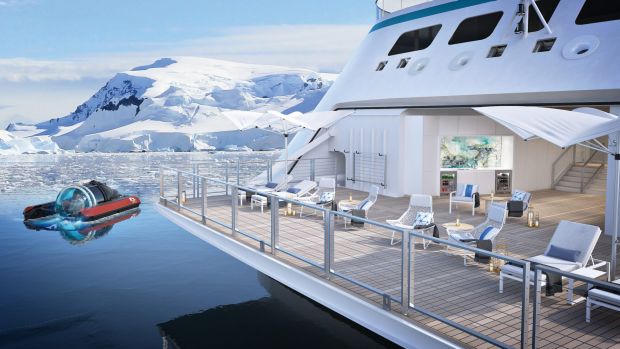Luxury Hotel Brands at Sea – Market Trends
Recent market research shows that together with the new demand created by generation z and millennials, the post-pandemic increase of leisure travels will boost the popularity of hotels, resorts and cruises lines, in the next incoming years. The global market size will reach an estimated USD 2,214 billion in 2030 and is expected to grow at a CAGR of 17.4% from 2022 to 2030: the resorts segment is expected to expand at a substantial CAGR of 17.1% over the forecast period, while the cruise lines segment is expected to grow at a considerable CAGR of 15.9% over the forecast period. This growth is attributed to the rising popularity of cruise lines among vacationers.
The hotels segment contributed significantly to the global market in 2021 while the cruise industry is showing a fast recovery in 2022. Hotels and cruise companies have recently implemented global expansion, partnerships, acquisitions & mergers, and diversification strategies through which hotel brands create successful cruise lines to gain market share. The arrival of new operators such as Virgin Voyages, Ritz-Carlton, Four Seasons and Aman Resorts revels how the perception of the cruising experience and hospitality at sea, have essentially changed among potential customers.
Challenges for the new hospitality concept
The constant growth in the cruise market, with new ships launched every year always with something more competitive in terms of on-board services and sailing experiences, shows that each cruise company has its own identity, unique selling propositions and market segment. Luxury resorts and hotel chains leverage on their high level of brand recognition and service standards, to gain competitive advantages within the market. Hence, understanding the challenges of recreating their brand at sea, ensuring consistency in service excellence and hospitality standards, is key for succeeding outside their existing customer segments. Nevertheless the cruise market is already very competitive and cruise companies, which have been operating for decades, gained their expertise and knowledge that evolved to cope with new market needs. For this reason, the hospitality land-based experience cannot be copy-pasted on-board a cruise ship. To ensure success, the new operators need to offer something not present in the market, new experiences, new market niches a blue ocean strategy. One of the biggest challenges is also that these hotel brands are venturing into a business they don’t know. Therefore combining seasoned cruise executives with hospitality professionals, without trying to clone a “floating hotel”, will ensure the design and the implementation of a new hospitality concept at sea.
It is interesting to see that the Ritz-Carlton Yacht Collection, the Four Seasons and Aman Resorts distance themselves from the cruise concept and don’t use the term “cruise” when marketing their new products. To attract existing customers that are already familiar with these brands, concepts such as “private super-yacht”, “yacht-collection” or “yacht-style cruising” are used.
Ensuring the service standards passengers are expecting comes with multiple challenges. Creating a new type of vessel that combines the best of a cruise ship and a yacht requires a hybrid design and structure. Public spaces will need to be downsized to create more intimate areas while hotel services need to be offered (some yachts’ vessels will be about 33.000 gross-tons and hold 190 passenger or even 32.000 gross-tons for 458 passenger). As a result, the cost could increase up to $2 million per berth. Last but not least, the smaller crew-areas that may affect the on-board living conditions, crew-welfare and the ratio staff to guests https://www.linkedin.com/pulse/hotels-cruise-ships-real-estate-assets-giulio-stella/.
Customer expectations at sea will be the same or even higher due to the new experience passengers will be looking for while sailing on-board luxury yachts and docking in remote areas unreachable by big cruise ships. Hotels brands will stick to their product and service standards, as these are the pillars of their success ashore. Nevertheless they will need to consistently transfer, carefully develop and maintain the standards they are marketing, to consolidate customer loyalty and brand re-engagement in the new business.
How company’s service standards can be consistently maintained on-board
Luxury hotels and resorts, land based, deliver hospitality service standards at their best. They combine service excellence, supported by well trained personnel, innovative resources and solutions, with great locations and interiors. They are places where advanced technologies and sustainable architecture, meet the environment and the social responsibility, making the commitment to sustainability and ESG values, a top priority for the business. In the same way, these key variables need to be taken into account when designing, implementing and maintaining service excellence at sea https://stellaconsulting.ch/business-modeling-development/.
The same level of standards has to be granted through all the customer journey and needs to be reflected in all the aspects of the service provided to passengers: easy and accommodating booking process; pickup and drop-off shuttle or car service; smooth and fast check-in and check-out; restaurants and menus designed by a Michelin-starred chefs; champagne and caviar bars; cigar room; dedicated personal assistants in loft-style apartments or suites; cabin facilities, bath linen and amenities; 24-hour room service; private luxury living with private dining area; private balcony and private whirlpool; infinity pools; a “marina” where guests can find paddle-boards, kayaks, windsurf boards and snorkeling equipment; dedicated kids’ club facility for young travelers; SPA and beauty salon; open decks transformed into a nightclub where guests can dance until sunrise.
Last but not least, the value proposition offered by the luxury yacht experience , is not only based on the on-board services provided to passengers: these companies need to clearly understand what a destination experience really means to today’s travelers. Exploring a new destination every day, making a deep connection with the places visited, is key to successfully compete within the new market.
How the brand would benefit from this type of diversification
Diversification strategies in the hotel and luxury business are nothing new. Once, the hotel luxury brand label was primarily attached to a single business unit, now it is embracing different brands, each one with its own identity and market segments, within the same hotel chains’ portfolio. Starwood, Hyatt, Marriott and Accor represent clear market examples. Even luxury brands with no credentials in hospitality such LVMH, Bulgari, Gucci and Armani, have diversified their brands into luxury hotels, bars and restaurants. This strategy has further consolidated the relationship with their clientele, offering experiences that consistently symbolize the brand.
Another example of diversification strategy, recently boosted by the new post pandemic’s approach to travel and the need of more privacy, is the development of the road trips business. Marriott, Kempiski, Four Sesaon and Aman Resorts are offering to their guests, tailor-made organized itineraries which include deluxe on-road catering and culinary experience, vintage or super cars, bespoke GPS tours and support vehicles. All features that turn the traditional concept of car travel into a unique experience that further typify the hotel brand.
All these diversification strategies have one key point in common. They all recognize the potential that hospitality has within the luxury market: an opportunity to enhance unique personalized brand experiences. In the same way luxury yachts can offer a unique brand experience at sea, while staying true to the DNA of the hotel chain. The shift of the diversification strategies towards high capital investments business, like the cruise business, is another clear sign of how hospitality today, is reinventing itself .
References
https://www.globenewswire.com/en/news-release/2022/09/14/2515843/28124/en/The-Worldwide-Hotels-Resorts-and-Cruise-Lines-Industry-is-Expected-to-Reach-2-214-Billion-by-2030.html
https://www.cruisetradenews.com/can-hotel-brands-create-cruise-lines/
https://www.travelweekly.com/Travel-News/Hotel-News/Luxury-hotel-brands-entering-cruising
https://hospitalityinsights.ehl.edu/disruptive-cruise-market-trends
https://hospitalityinsights.ehl.edu/redefining-luxury-hotel-service
https://www.cntraveler.com/story/ritz-carlton-evrima-spa-terrace-onboard-obsession
https://hbr.org/2004/10/blue-ocean-strategy
https://www.linkedin.com/pulse/hotels-cruise-ships-real-estate-assets-giulio-stella/
https://www.theguardian.com/business/2022/oct/15/ritz-carlton-launches-minimum-5000-a-week-luxury-yacht-cruises
https://www.hospitalitynet.org/opinion/4083534.html
https://www.matterofform.com/news/articles/the-diversification-of-the-hospitality-industry
https://www.cntraveler.com/story/orient-express-sailing-yacht-2026

